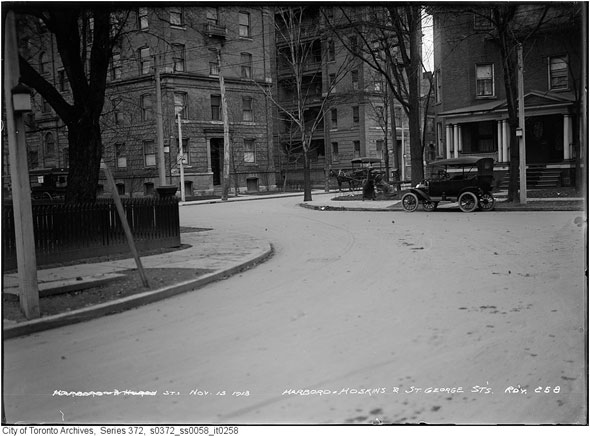 |
| The Annandale, Sydenham Street Kingston |
The Apartment. Where the urbane sophisticated city dweller lived. When I was a kid in a rambling frame double farm-house surrounded by several hundred difficult to discipline acres, life in one of these tidy compact spaces was my grown-up dream. The 1960 Billy Wilder film, its high-rise Upper West Side apartment bustling with moral light-weights and their amorous liaisons, described a life-style so far removed from our own.
And it was all about the apartment. Even my aunt, who worked as a saleslady at Eaton's in down-town Picton, and lived in an apartment above a main street shop, was glamorous to me, because of her address.
Here are a few of my favourite early apartments.
 |
| Ward Apartments, King Street, Picton |
 |
| Have nothing on this Moderne brick on Bridge St. Belleville |
The building at the top is Annandale, in Kingston. I wrote about it
once over a year ago, and included a few extra photos and a
link (containing some great historic photos) to the Annandale blog - for now the building is a condominium community. Annandale is a complex which grew up over time on the 1849 Carruthers Villa estate; the original stone house forms part of it, with an extra 1928 storey and a name change to Annandale Court Apartments. Later a three storey annex was built, and by 1931 the five-storey plus basement third stage, Kingston's first high-rise (possibly) was being occupied. Definitely worth a walk around the block, next time you're by.
 |
| 28 Cardero Street, Vancouver |
The grey streamlined moderne building above was built around a Second Empire house. Really. An article appeared in a recent issue of
County magazine, written by Phil Ainsworth, the publication's intrepid house researcher. This very fine moderne structure, with all the required stylistic elements, was a concrete shell, built by Clayton Ward from 1937 - 42, around a three-storey 1875 mansion badly in need of a facelift. And what a facelift. Six spacious apartments. Has fooled a lot of people for a long time. Fooled me in
2012.
I photographed this greenery cloaked buff brick apartment in Vancouver's West End, for its emotional rather than architectural significance. I lived there in the late 1970s, and it was where I first entertained the gentleman caller with whom I still share my days. We revisited in 2013, walking up Robson Street from Stanley Park through a proliferation of shiny towers and upmarket eateries. I was astonished to find my old home still standing, and even more surprised to find the row of tiny bungalows facing it all in good repair, with all that wonderful west coast vegetation proliferating.
And then I ran out of photos of apartment buildings, apartment houses, apartment blocks. I dug up a bit of history, though.
 |
| City of Toronto Archives |
This
blog TO article does a great history of that city's first apartment blocks. I love this line: "it's hard to imagine a time when renting a small portion of a larger building was a radical, even a shockingly salacious way of life." Fabulous! The January 25, 2014 article by Chris Bateman goes on to explain that there were no purpose-built apartment buildings in the city before 1899 (humble folks rented rooms or floors of subdivided houses, of course.) First off the mark were the tony brick and stone St. George Mansions at 1 Harbord Street, opening in 1904 with six storeys and 34 apartments housing the well-heeled. The next year, the Alexandra's 7 stories of brick, stone and steel offering 72 suites. For a look at these pioneers, go to the blogTO link; neither building survived long after
WWII.
 |
| photo courtesy Chris Ryan |
While looking for information on an apartment I once knew and loved in Ottawa (which the Vancouver building reminded me of) I came across Christopher Ryan's fascinating blog The Margins of History written by a self-confessed history nerd (love the site name!) His Tumblr site with loads of Ottawa architectural photos, is also well worth a visit.The apartment I was looking for is the Keniston, which has traded its down-trodden front lawn for a bazaar of sorts. Don't have a photo (who thought of taking photos in the 60s?) but here's a Street View link. My neighbourhood, Elgin Street South, was lined with early c20 apartment blocks, some heavy Edwardian in feel, others Streamlined Moderne. A favourite was always Park Square, across from the (then) Museum of Natural History. Here's a great article about Park Square, considered "exceptionally modern" in 1937 when it first rented; it's written by Christopher Ryan in Ottawa Start, Unfortunately the street became a loud grimy traffic corridor leading to the Queensway, immediately to the south and lost its cachet.






No comments:
Post a Comment